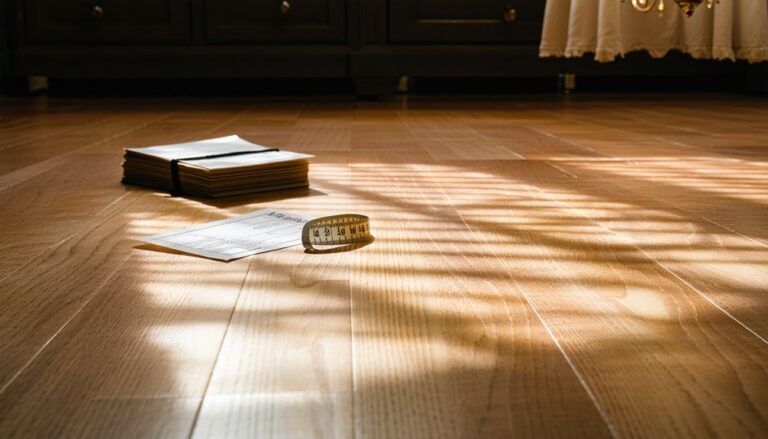To restore hardwood floors without sanding, start by evaluating their condition for scratches and signs of damage. Clean using a pH-balanced cleaner and a microfiber mop, avoiding harsh chemicals. Next, buff the floor with medium to fine grit pads to eliminate surface imperfections, then polish with a quality product for added shine. Consider applying a wood floor restorer with urethane or acrylic components to enhance the finish. Implement preventive maintenance, like regular cleaning and using area rugs, to prolong the floor's life. There's much more you can do to achieve stunning results and maintain their beauty.
Assessing Your Floors

Before diving into restoration, it is crucial to assess your hardwood floors to determine their condition. Begin with a thorough damage assessment, identifying any scratches, dents, or discoloration. Look for signs of water damage, such as warping or cupping, which could compromise the integrity of the wood. Pay attention to the finish; if it's worn or dull, it may require revitalization. Using a flashlight, inspect difficult-to-see areas and corners for hidden issues. Document your findings, as this will guide your restoration efforts. Understanding the exact floor condition allows you to choose the right restoration method, ensuring you maintain the wood's natural beauty while achieving the desired results without sanding. Your awareness empowers you to take effective action.
Cleaning Techniques
To effectively restore your hardwood floors, proper cleaning techniques are essential. Start by selecting the right cleaning products; opt for pH-balanced solutions specifically designed for hardwood. Avoid harsh chemicals that can damage the finish. Use a microfiber mop to gently remove dust and grime, ensuring you don't scratch the surface. For deeper cleaning, mix a few drops of your chosen cleaning product with water, and dampen the mop—never saturate the floor. Regular floor maintenance is vital; establish a routine that includes sweeping or vacuuming to prevent dirt buildup. Remember, consistency is key to preserving the beauty and longevity of your hardwood floors. Following these steps will help maintain their integrity without the need for sanding.
Buffing and Polishing

While many homeowners consider sanding as the primary method for restoring hardwood floors, buffing and polishing can be equally effective without the mess and disruption. Buffing techniques involve using a floor buffer or a rotary scrubber to remove surface imperfections and scuffs. You'll want to start by selecting the right buffing pad—medium to fine grit is ideal for most floors. After buffing, applying quality polishing products will enhance the shine and protect the wood. These products often contain wax or polymers that bond to the surface, creating a durable finish. Always follow the manufacturer's instructions for best results, ensuring your floors not only look great but also withstand daily wear and tear. Embrace these methods for a quick, effective restoration.
Using Wood Floor Restorers
Using wood floor restorers can greatly revive your hardwood floors without the need for extensive sanding. These products are designed to penetrate and enhance the wood's natural finish, restoring luster and durability. When selecting a wood floor restorer, it is crucial to take into account various product comparisons based on ingredients, application methods, and drying times. Look for restorers that contain urethane or acrylic components, as they provide a protective layer against wear and tear. Before application, verify your floor is clean and free from debris. Apply the restorer evenly using a mop or applicator, following the manufacturer's instructions. With the right choice, you'll enjoy a refreshed appearance and extended life for your hardwood floors, giving you the freedom to embrace your space.
Preventive Maintenance Tips

Maintaining the beauty and integrity of your hardwood floors requires consistent preventive measures, as neglect can lead to costly repairs or refinishing. Start with regular cleaning; use a soft-bristle broom or vacuum specifically designed for hardwood to eliminate dirt and grit. Next, apply preventive care by using area rugs in high-traffic zones to minimize wear. Always use floor protection under furniture legs to prevent scratches. Avoid using water or harsh chemicals that can damage the finish; instead, opt for a pH-balanced cleaner. Finally, keep humidity levels stable, as excessive moisture or dryness can warp or crack your flooring. By taking these steps, you'll guarantee your hardwood floors remain stunning for years to come.
Frequently Asked Questions
Can I Restore Laminate Floors Using Similar Methods?
Imagine a painter reviving a canvas, bringing life back to the colors without starting anew. When it comes to laminate floors, you can use similar laminate restoration techniques. Regular laminate floor maintenance, like cleaning with appropriate solutions and applying a polish, can greatly enhance their appearance. While you can't sand laminate, focused care will rejuvenate its look, allowing you to enjoy a refreshed space without the hassle of extensive renovation.
How Often Should I Restore My Hardwood Floors?
You should consider your hardwood floors' restoration frequency based on traffic and wear. Generally, it's wise to restore every 3 to 5 years, but high-traffic areas may need more frequent attention. For maintenance tips, regularly clean with a microfiber mop, avoid harsh chemicals, and promptly address scratches or dents. By staying proactive, you'll preserve their beauty and extend their lifespan, granting you the freedom to enjoy your floors without constant worry.
What Products Should I Avoid for Hardwood Restoration?
When it comes to restoring hardwood floors, think of your surfaces as a delicate ecosystem. You'll want to avoid chemical cleaners that contain harsh solvents, as they can strip protective finishes and harm the wood. Likewise, abrasive materials like steel wool or scrubbing pads can scratch and damage your floor's surface. Instead, opt for gentle, pH-balanced products designed specifically for wood, preserving the beauty and integrity of your floors while maintaining their natural freedom.
Is Professional Help Necessary for Restoring Hardwood Floors?
Whether you need professional help for restoring hardwood floors depends on your skills and the project's complexity. DIY techniques can save you money, but you should weigh cost considerations against your ability. If you're comfortable with refinishing products and techniques, you might handle it yourself. However, if the damage is extensive or you're unsure, hiring a professional could guarantee a quality finish and save time, providing peace of mind in the long run.
Can Pets Damage Restored Hardwood Floors?
Did you know that around 70% of pet owners report some level of floor damage? If you're concerned about your restored hardwood floors, it's crucial to take pet precautions. Using area rugs and mats can provide floor protection against scratches and accidents. Regular nail trimming and paw cleaning can also help minimize wear and tear. By being proactive, you can enjoy both your pets and your beautiful floors without worry.




